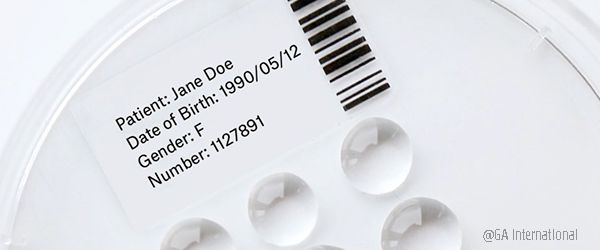
Label All Things
Labeling is one of the most important things a lab can do to prevent errors. As with all equipment, labels used for identifying plates, tubes, vials, and cryo straws should be tested for volatile organic compounds (VOCs) prior to use, as VOCs can diminish the quality of sperm, eggs, and embryos, reducing the chance that the procedure will yield a live birth.1 Ideally, labels should be printed with 1D or 2D barcodes, which improves your ability to track and trace samples as they’re processed and stored. For barcode labels, thermal-transfer printers should be used, as they provide a crisp printout and afford the most resistance to cryogenic freezing and harsh solvents, including disinfectants (e.g. Oosafe®) and dimethyl sulfoxide (DMSO).
In IVF clinics, specialized labels should be applied for:
Cryo straws – There are labels specially designed to wrap around cryo straws and other vitrification devices, which are used to store eggs, sperm, and embryos in liquid nitrogen. Cryo straw labels, such as Cryo-StrawTAG™, resist temperatures as low as -196°C (-321°F) as well as solvents, like DMSO, used in the vitrification process to freeze donor cells.
Tubes & vials – Many families of cryogenic labels exist for tubes and vials. They can be customized for size, color, and configuration, which helps tailor the label to your specific need. Some labels, like CryoSTUCK®, can even be applied to previously frozen tubes. Self-laminating labels are also available to provide additional protection against harsh conditions.
Plates – For plates, labels should only be applied to the side and bottom of the dish. When labeling the bottom of the dish, barcodes should be reverse-printed on transparent labels, which allows the scanner to read the barcode from the top of the plate (without needing to turn the plate upside down to read it).
Canes, metal racks, & canisters – Labeling storage containers and racks is a great way to identify the contents inside each one, eliminating the need to unnecessarily take the wrong container out of storage. Like cryo straws, these labels resist cryogenic freezing but are specialized for adhering to metal.
Electronic Witnessing
Implementing an electronic witnessing system (EWS) combined with barcode labels can help prevent errors from creeping into your lab. With an EWS, technicians are required to scan each label throughout the entire procedure, efficiently tracking all samples and making sure mistakes aren’t being made, especially when it comes to identifying the donor(s). An EWS will also increase sample traceability, effectively safeguarding against using the wrong eggs or sperm to produce embryos. For systems that employ RFID labels, merely positioning two samples from the incorrect donors next to each other will notify the EWS that an error is likely to occur and will pause the procedure until the problem is resolved.
The Swiss Cheese Model
The Swiss Cheese Model refers to a methodology for dealing with errors in medicine. It proposes that using a “bad apple” approach to errors, where individuals are called out for specific actions, is less productive than implementing systemic changes to the workflow itself, making it less likely for errors to occur.2 In the clinic, it promotes an open environment, where people are free to discuss their errors, making it possible to prevent them in the future by actively engaging with the system itself and developing error-reducing strategies, such as using barcodes or RFID technology.3
Nanobarcodes
Though these have yet to hit the market, nanobarcoding is one of the most innovative ways to identify donor cells. In 2015, Sergi Novo and colleagues published an article describing the use of tiny polysilicon wafers to efficiently label eggs, sperm, and embryos. These wafers carry 8 bits of binary information, acting as miniature barcode labels that could be read using a handheld scanner. As a first step to substantiating these nanobarcodes for IVF purposes, they showed that they did not reduce the quality or quantity of sperm and had no effect on the pregnancy rate of rabbits, making them an intriguing option should they pass all future clinical validation.4
With so much riding on even one cycle of IVF—upwards of $10,000 on average, with an additional $450 per year just to store eggs—errors can be disastrous. These errors can result in babies born with the wrong parental lineage or unnecessary recollection of sperm and/or eggs, prompting legal ramification and tarnishing a clinic’s reputation. Therefore, it’s important to ensure all samples are properly labeled, that you have an efficient system in place to track and trace all donor cells and that errors are dealt with in a thoughtful and constructive way. Ultimately, with these barriers in place, your IVF lab should be running smoothly and productively for years to come.
LabTAG by GA International is a leading manufacturer of high-performance specialty labels and a supplier of identification solutions used in research and medical labs as well as healthcare institutions.
References:
- Khoudja RY, Xu Y, Li T, Zhou C. Better IVF outcomes following improvements in laboratory air quality. J Assist Reprod Genet. 2013;30(1):69-76.
- Reason J. Human error: Models and management. West J Med. 2000;320(7237):768-770.
- Kennedy D. Analysis of sharp-end, frontline human error: Beyond throwing out “bad apples.” J Nurs Care Qual. 2004;10(2):116-122.
- Novo S, Mora-Espí I, Gómez-Martínez R, et al. Traceability of human sperm samples by direct tagging with polysilicon microbarcodes. Reprod Biomed Online. 2015;31(2):162-170.